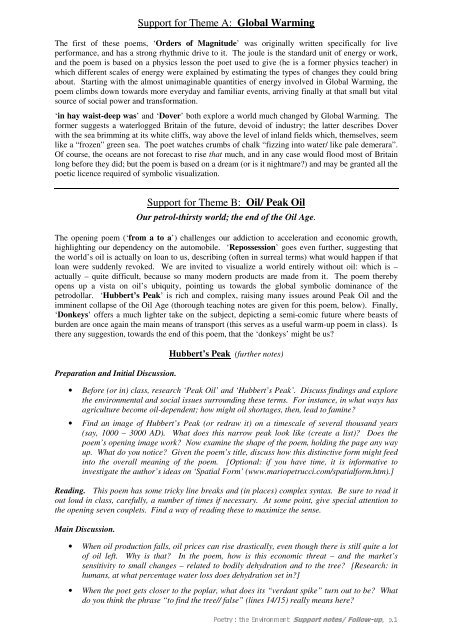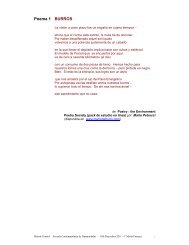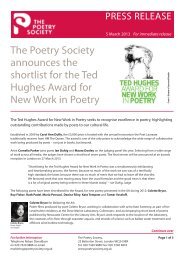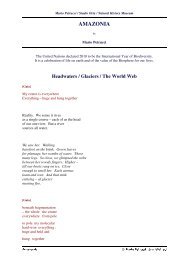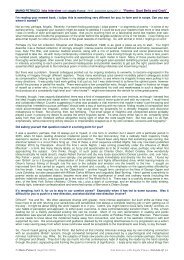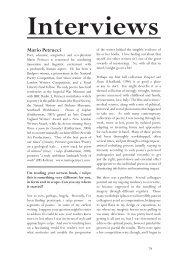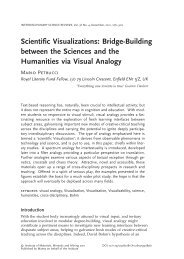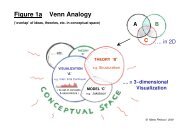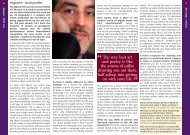Create successful ePaper yourself
Turn your PDF publications into a flip-book with our unique Google optimized e-Paper software.
Support for Theme A: Global Warming<br />
The first of <strong>the</strong>se poems, ‘Orders of Magnitude’ was originally written specifically for live<br />
performance, and has a strong rhythmic drive to it. The joule is <strong>the</strong> standard unit of energy or work,<br />
and <strong>the</strong> poem is based on a physics lesson <strong>the</strong> poet used to give (he is a former physics teacher) in<br />
which different scales of energy were explained by estimating <strong>the</strong> types of changes <strong>the</strong>y could bring<br />
about. Starting with <strong>the</strong> almost unimaginable quantities of energy involved in Global Warming, <strong>the</strong><br />
poem climbs down towards more everyday and familiar events, arriving finally at that small but vital<br />
source of social power and transformation.<br />
‘in hay waist-deep was’ and ‘Dover’ both explore a world much changed by Global Warming. The<br />
former suggests a waterlogged Britain of <strong>the</strong> future, devoid of industry; <strong>the</strong> latter describes Dover<br />
with <strong>the</strong> sea brimming at its white cliffs, way above <strong>the</strong> level of inland fields which, <strong>the</strong>mselves, seem<br />
like a “frozen” green sea. The poet watches crumbs of chalk “fizzing into water/ like pale demerara”.<br />
Of course, <strong>the</strong> oceans are not forecast to rise that much, and in any case would flood most of Britain<br />
long before <strong>the</strong>y did; but <strong>the</strong> poem is based on a dream (or is it nightmare?) and may be granted all <strong>the</strong><br />
poetic licence required of symbolic visualization.<br />
Support for Theme B: Oil/ Peak Oil<br />
Our petrol-thirsty world; <strong>the</strong> end of <strong>the</strong> Oil Age.<br />
The opening poem (‘from a to a’) challenges our addiction to acceleration and economic growth,<br />
highlighting our dependency on <strong>the</strong> automobile. ‘Repossession’ goes even fur<strong>the</strong>r, suggesting that<br />
<strong>the</strong> world’s oil is actually on loan to us, describing (often in surreal terms) what would happen if that<br />
loan were suddenly revoked. We are invited to visualize a world entirely without oil: which is –<br />
actually – quite difficult, because so many modern products are made from it. The poem <strong>the</strong>reby<br />
opens up a vista on oil’s ubiquity, pointing us towards <strong>the</strong> global symbolic dominance of <strong>the</strong><br />
petrodollar. ‘Hubbert’s Peak’ is rich and complex, raising many issues around Peak Oil and <strong>the</strong><br />
imminent collapse of <strong>the</strong> Oil Age (thorough teaching notes are given for this poem, below). Finally,<br />
‘Donkeys’ offers a much lighter take on <strong>the</strong> subject, depicting a semi-comic future where beasts of<br />
burden are once again <strong>the</strong> main means of transport (this serves as a useful warm-up poem in class). Is<br />
<strong>the</strong>re any suggestion, towards <strong>the</strong> end of this poem, that <strong>the</strong> ‘donkeys’ might be us?<br />
Preparation and Initial Discussion.<br />
Hubbert’s Peak (fur<strong>the</strong>r notes)<br />
• Before (or in) class, research ‘Peak Oil’ and ‘Hubbert’s Peak’. Discuss findings and explore<br />
<strong>the</strong> environmental and social issues surrounding <strong>the</strong>se terms. For instance, in what ways has<br />
agriculture become oil-dependent; how might oil shortages, <strong>the</strong>n, lead to famine?<br />
• Find an image of Hubbert’s Peak (or redraw it) on a timescale of several thousand years<br />
(say, 1000 – 3000 AD). What does this narrow peak look like (create a list)? Does <strong>the</strong><br />
poem’s opening image work? Now examine <strong>the</strong> shape of <strong>the</strong> poem, holding <strong>the</strong> page any way<br />
up. What do you notice? Given <strong>the</strong> poem’s title, discuss how this distinctive form might feed<br />
into <strong>the</strong> overall meaning of <strong>the</strong> poem. [Optional: if you have time, it is informative to<br />
investigate <strong>the</strong> author’s ideas on ‘Spatial Form’ (www.mariopetrucci.com/spatialform.htm).]<br />
Reading. This poem has some tricky line breaks and (in places) complex syntax. Be sure to read it<br />
out loud in class, carefully, a number of times if necessary. At some point, give special attention to<br />
<strong>the</strong> opening seven couplets. Find a way of reading <strong>the</strong>se to maximize <strong>the</strong> sense.<br />
Main Discussion.<br />
• When oil production falls, oil prices can rise drastically, even though <strong>the</strong>re is still quite a lot<br />
of oil left. Why is that? In <strong>the</strong> poem, how is this economic threat – and <strong>the</strong> market’s<br />
sensitivity to small changes – related to bodily dehydration and to <strong>the</strong> tree? [Research: in<br />
humans, at what percentage water loss does dehydration set in?]<br />
• When <strong>the</strong> poet gets closer to <strong>the</strong> poplar, what does its “verdant spike” turn out to be? What<br />
do you think <strong>the</strong> phrase “to find <strong>the</strong> tree// false” (lines 14/15) really means here?


